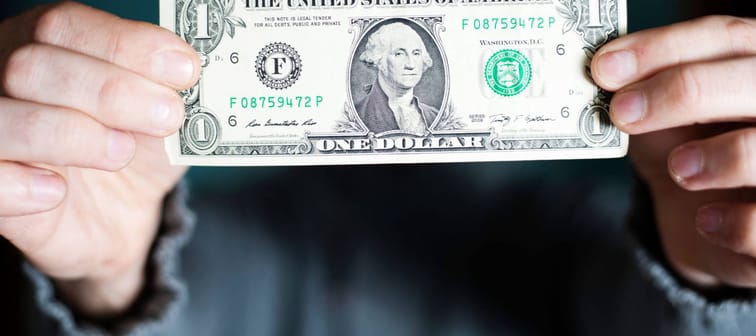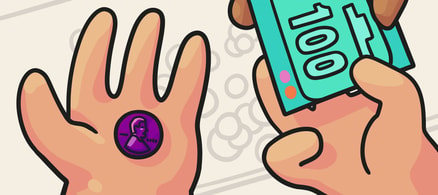1. Who is the face of the $1 bill?

George Washington has been the face of the $1 bill since 1869.
Before Washington became the iconic face of the $1 bill, the very first $1 currency featured a portrait of Salmon P. Chase, who was the secretary of the Treasury at time. The $1 was then redesigned with Washington's portrat in 1869.
And, in the late 1800s America's first first lady Martha Washington appeared on $1 "silver certificates." Today, those notes sell for $1,000 or more.
Meet Your Retirement Goals Effortlessly
The road to retirement may seem long, but with WiserAdvisor, you can find a trusted partner to guide you every step of the way
WiserAdvisor matches you with vetted financial advisors that offer personalized advice to help you to make the right choices, invest wisely, and secure the retirement you've always dreamed of. Start planning early, and get your retirement mapped out today.
Get Started2. The No. 13 is a thing

The dollar bill has never forgotten America's 13 original colonies. The number 13 is featured repeatedly in its design, such as in the 13 stars above the eagle, the pyramid's 13 levels or steps, and the 13 bars on the shield.
In its talons, the eagle holds 13 arrows and an olive branch with 13 leaves and 13 olive fruits.
It may or may not be a coincidence that there are also 13 letters in the two mottos printed on the $1 bill, "Annuit Coeptis" and "E Pluribus Unum."
3. Some $1 bills are 'star notes'

If you pay attention the next time you find yourself with a stack of $1 bills, chances are you'll find at least one with a star printed next to the serial number.
These are known as (surprise!) "star notes." And they're replacement bills.
If a mistake or defect is discovered on a $1 bill after it has been printed, it's destroyed and a new bill is issued in its place, with a star after the serial number.
Kiss Your Credit Card Debt Goodbye
Having a single loan to pay off makes it easier to manage your payments, and you can often get a better interest rate than what you might be paying on credit cards and car loans.
Fiona is an online marketplace offering personalized loan options based on your unique financial situation.
When you consolidate your debt with a personal loan, you can roll your payments into one monthly installment. Find a lower interest rate and pay down your debt faster today.
Get Started4. You can track where a dollar bill goes

Have you ever been curious where that dollar bill in your wallet has been? There's an easy way to find out.
Go to WheresGeorge.com, enter the serial number of your bill and your ZIP code.
The site will show all the cities, states, and countries where other people have reported holding your bill. And, you'll be able to track its movements as it continues to circulate.
5. Life span of a $1 bill
Not only does money not grow on trees, but it also doesn't stick around as long as you may think.
The Federal Reserve estimates that the average $1 bill lasts just 4.8 years.
That may not seem like a long time, but $5 dollar bills last only 3.8 years, on average. And, $10 bills tend to last 3.6 years. Coins tend to stay in circulation for much longer.
6. The $1 bill isn't the most common

There are literally billions of dollar bills in circulation: 14 billion to be exact, according to the latest data from the Federal Reserve.
The $1 bill may be the denomation you see most often in your wallet, but it's not the most widely circulated type of U.S. currency.
That would be the $100 bill, the Fed says. Some 17.7 billion of them are floating around out there.
7. The cost to make a $1 bill

"Cheap money" usually refers to loans available at low interest rates, but the $1 bill gives that term new meaning.
Each note costs just 7.5 cents to produce, says the Federal Reserve.
Maybe it's fitting that the $100 bill is far more expensive to make — relatively speaking. Each $100 dollar note costs the government a whole 17 cents.
8. Your house may be made of money
Where do dollar bills go when they die? They might be all around you and you don't even know it.
When bills become too old and worn out, they are taken out of circulation and are shredded by the Federal Reserve. And then — ironically enough — the old greenbacks get even more green.
The Fed sometimes sells shredded bills to companies that use them in building materials. Recycled currency may be in the shingles on your roof or the insulation in your walls.
9. The $1 bill won't go out of style

While you may see occasional redesigns of other U.S. currency, it's unlikely that the $1 bill will get a makeover any time soon.
Larger bills have been updated to add counterfeiting prevention features, but the government doesn't feel a need to do that with the $1 bill becaue isn't exactly a favorite of counterfeiters.
A section of the annual Financial Services and General Government Appropriations Act even forbids altering the dollar bill's design.
10. Ben Franklin didn't want the eagle

The back of the dollar bill features the bald eagle, a proud symbol of the United States. But if Benjamin Franklin had gotten his way, we'd be seeing a turkey there.
Franklin once explained in a letter that he found the eagle "a bird of bad moral character" because he said it wasn't responsible enough to do its own fishing.
He thought the turkey would be a much more suitable choice. Franklin described it as a "more respectable bird and ... a true original native of America."
Sponsored
Follow These Steps if you Want to Retire Early
Secure your financial future with a tailored plan to maximize investments, navigate taxes, and retire comfortably.
Zoe Financial is an online platform that can match you with a network of vetted fiduciary advisors who are evaluated based on their credentials, education, experience, and pricing. The best part? - there is no fee to find an advisor.







